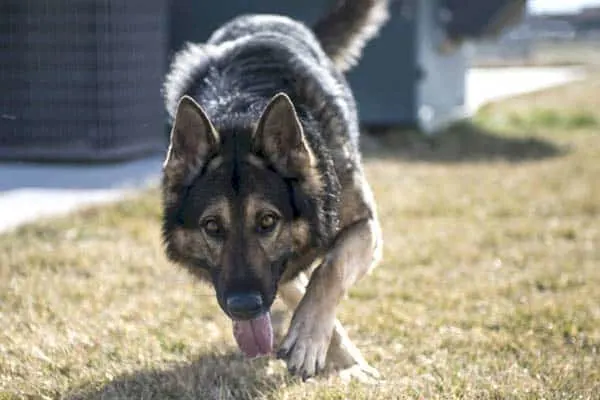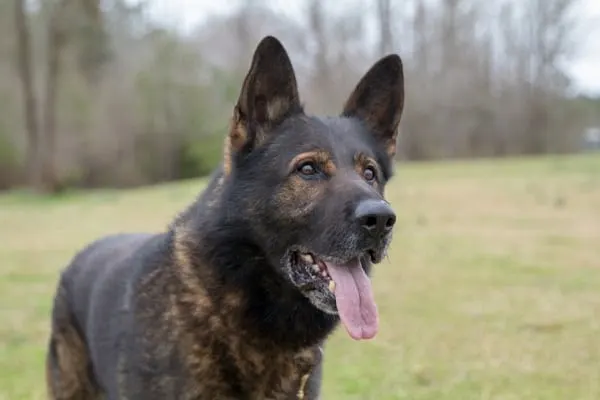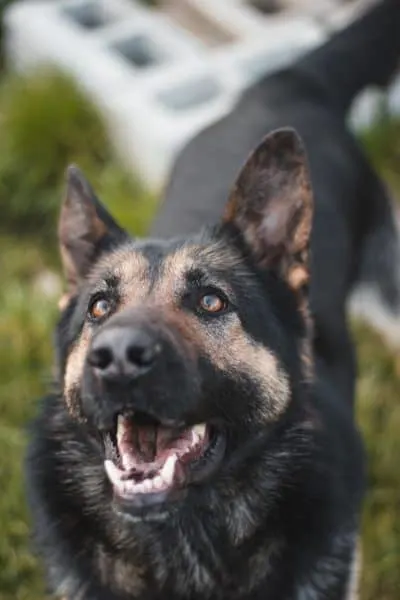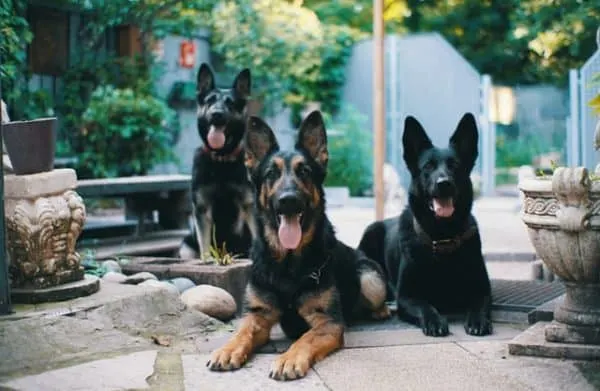Czech German Shepherd: Training and Living with the Ultimate Canine
If you are a fan of dogs, then you are probably already in love with the Shepherd.
You have surely heard a lot about the more common Shepherd breeds: West German Shepherds, East German Shepherds, working lines, show lines, or the American-bred variations of the Shepherd that are becoming tremendously famous.
The Czech German Shepherd is, however, one of the lesser-known breeds of the Shepherd.
Though considered more of an offshoot, the Czech German Shepherd has a few unique traits and quite an interesting history.
This article will entail a short history of the Czech German Shepherd, its appearance, temperament, and training.
I will also discuss some of the health issues of the dog and its feeding. But, first, let’s have a quick preview of the history of the breed.

Czech German Shepherd History
Although the dog was not professionally bred until 1955, its breed reaches far back to communist Czechoslovakia, 1899.
The Czech army had found the dogs to be excellent servants, muscular, and intelligent. They used the Czech German Shepherd as a working dog, mainly patrolling the Czech border for illegals.
The kennel used for breeding the Czech German Shepherd was put under the control of the border control arm of the Czech Army.
The dogs were often bred from the East German Shepherds with similar masculinity, intelligence, energy, and dark coloration characteristics.
The Czech Shepherds, like the East German Shepherds, are a favorite for most people who have owned them because of their loyalty.
The two breeds have very similar bloodlines seeing that they originate from the former Soviet Bloc.
However, the two breeds have unique characteristics that differentiate their abilities. Despite this, most people often confuse one for the other.
While it is a relatively new breed, the Czech German Shepherd is becoming quite popular around the world.
As a result, breeding of the dog is no longer as heavily regulated as it was a few years ago but is still regulated in Europe more than in the US.
Czech German Shepherd Appearance
The Czech German Shepherd has the typical facial appearance of the ordinary German Shepherd Dog, a strong jaw, a thick head, and upright pointed ears.
They are noticeably larger than most German Shepherd breeds, with males reaching up to 68 pounds, while the females weighing between 49 to 71 pounds.
Czech German Shepherd puppies will continue growing until they are one year old.
The Czech German Shepherd has a dense appearance that makes it look significantly more muscular and powerful. For this reason, the dog was named the best working dog in a dog show in 1955.
The dog breed also has a strong and athletic body, perfect for catching criminals when they were bred in Czechoslovakia. In addition, they have a deep chest and thick front paws.
The Czech German Shepherd has a sable coat, which means that they have patches around their legs colored cream, tan, or red with banded fur tips over most of its body.
The pigmentation gives the dog a general black appearance.
The dog’s colors are more uniform than those of the American German Shepherd. The colors range from dark brown to wolfish gray to black.
Czech German Shepherd Temperament
German Shepherds have been known to have a basic temperament. However, these dogs can become aggressive if they are trained to be.
This is because they were originally bred for awareness and endurance in harsh conditions.
Today the Czech German Shepherd is mostly bred for its subtle characteristics. Though the dogs can become very aggressive, they can use their energy to play with toys and cuddle with their owners.
Being one of the most loyal breeds of German Shepherds, the Czech Shepherds are calm around their owners.
They are also intelligent and can tell when their owner is agitated. They can be great with children, though not all dogs tolerate kids who pull their ears and fur.
You should keep a close eye on little kids around any dog. However, a day’s walk and playtime are usually sufficient to burn some energy that will keep them from being hyperactive around your kids.

Czech German Shepherd Training
Like most other German Shepherd breeds, the Czech German Shepherd is relatively easy to train since they have an impressive learning capacity.
Besides being highly intelligent, the dogs are also always eager to impress their masters with high-performance levels.
The most effective way of training Czech German Shepherds is through positive reinforcement. It is generally the same case with children and any intelligent animal.
By rewarding good behavior, you can encourage the dogs to keep up with the behavior. Rewards are usually treats of the dogs’ favorite food or simply showing them affection.
The Czech breed can also be trained intensively through a program known as Schutzhund.
The plan was initially put in place for the East German Shepherd. However, since the two breeds are so similar, they are also great candidates for the program.
Czech German Shepherds can also be trained through a method known as Nothing In Life Is Free (NILIF). The training is designed to teach dogs how to ask for something.
For instance, if the dog wants a treat, they must sit and wag their tail, and then they will get the treat. NILIF is among the best methods to teach your dog patience and manners.
When training your dog at home, try to ignore its bad behaviors at all costs. Since the dog is intelligent, he will notice that some actions are not rewarded or do not please his master.
If you praise him when he sits, he will realize that sitting when given the command gets your attention.
You could also inquire about basic commands that the Czech German Shepherd should learn with relative ease.
The most common commands used to train dogs include Stay, Sit, Down, Forward, and sometimes shake and roll. The latter is taught to dogs later when they want a treat.
It is essential to stay calm and patient through the training. However, you must also remain assertive and consistent with commands so that the puppy can realize what you want them to do.
Do not be unnecessarily harsh when he gets the command wrong. Instead, show him you are his master.
When issuing commands, keep the same tone and use the same procedures to achieve the commands each time you issue them.
Dogs are highly responsive to high-pitched voices. It lets them know when their master is happy with their performance.
Anything you say to a dog in a high-pitch voice makes the dog think you are happy with them, while anything said in a low pitch shows the dog that something is wrong.
A piece of advice I would like to share with you about training dogs is to use the same leash and the same training zone every time.
This is so that your dog can recognize the difference between playtime and training time.
You should start training your Czech German shepherd puppy as soon as you get him. If you wait too long, bad behaviors will be hard to break.
At the start of training, discourage the puppy from jumping, chewing, and barking. Consistency is essential when training a dog: do not let him jump even once.
You can watch puppy Czech German Shepherd manners training in this video, which will teach you how to train your dog to stop bad habits and reward him for following commands.

Feeding the Czech German Shepherd
The Czech German Shepherd dog breed typically needs between two and four cups of dry food in a day. You could split the dry food into two or three meals before sunset.
Dog food bags are often labeled with the exact amounts you should feed your dog, depending on his weight.
Consult your veterinarian if you are not sure about the ideal amount of food for your dog. While your dog might act hungry at the time, be sure to feed him only the directed amount of food.
Over-feeding your dog could make him overweight and lazy. It could also lead to bone and joint problems.
Overweight German Shepherds are more likely to get hip dysplasia at a young age. However, if your dog has longer exercising hours, giving him a little more food may not be harmful.
Again, it is essential to contact a veterinarian if you are uncertain whether your dog needs more food.
Dog food varies by breed, health, age, weight, metabolism, and activity level. If your Czech German Shepherd has health issues, he may require a special diet.
However, you need to consult a veterinarian in case your dog has any symptoms of health issues.
Read the package carefully before purchasing dog food to ensure it contains the nutrients necessary for the growth of bones, strong muscles, and an active lifestyle.
It is essential to keep your Czech German Shepherd supplied with clean drinking water on a daily basis. Clean and refill the dog’s water bowl twice or three times daily if necessary.
Water will prevent your dog from dehydration and keep him healthy. The easiest way to tell if your dog is thirsty or dehydrated is a dry nose.
When rewarding your Czech German Shepherd with treats, make sure you moderate the frequency. Your dog loves the taste of treats, but most of them are full of fats.
Feeding your dog with too many treats will make them overweight.
Your dog might love the taste of cheese and steak, but I would advise against feeding them any human food.
By feeding him human food, your Czech German Shepherd might start to ignore his dog food since it is not as tasty. Eventually, your dog might not want to eat any dry dog food at all.
Apart from making your dog quit his usual food, human food can also affect your dog’s health.
For instance, your dog’s digestive tract might not be able to digest the harsh chemicals, preservatives, and spices that human food contains.
Your dog might also become overweight due to the fat contained in human foods. Human foods could also eventually lead to your dog’s death.
Most human food components, including onions, chocolate, raisins, salt, and alcohol, can be extremely harmful to your dog.
According to the American Kennel Club (AKC), the Czech German Shepherd prefers a high-quality kibble that is grain-free with raw supplements.

Common Health Issues in Czech German Shepherds
Just like other types of German Shepherds, Czech Shepherds are prone to eye and ear infections, and hip dysplasia.
Take your Czech German Shepherd to a veterinarian at least once every year, and whenever any symptoms arise.
With proper feeding, exercise, and checks by your veterinarian, your Czech Shepherd is less likely to be at risk of health complications.
You can manage ear infections by carefully cleaning the ears with soft earbuds and disinfectant solutions. However, your dog could get irritated by the solution’s components, so be careful when applying.
By simply looking at your Czech Shepherd’s eyes, you can tell if he has an eye infection. Eyes with infections are usually teary.
However, it is not always that easy to tell whether a dog has an eye infection. Taking your dog to a veterinarian regularly will make it easier to detect eye infections early enough.
Czech German Shepherd as a Family Pet
Today, they are bred as family pets, unlike their less docile ancestors. They, however, still require daily exercise but have no problem playing with your kids and toys.
How Much Do Czech German Shepherds Cost?
It will be cheaper for you to source your new Czech German Shepherd in the United States.
When doing so, you will find the price can range between $500 and $1,800, depending on the titles for the dog and the studs that were used.
Czech German Shepherd puppies from Europe are often much more expensive due to the breeding regulations in the Czech Republic, Slovakia, and Germany.
The higher price wouldn’t even include the shipping costs involved.
However, if you can afford it, getting your pup from Europe is ideal because they are much less likely to have the more common health problems experienced by this dog breed, like hip dysplasia.
Czech German Shepherd Breeders
Czech German Shepherds are considered high-quality dogs, so you want to avoid purchasing one from a backyard breeder or puppy mill. Instead, look only at a reputable breeder.
If not, the dog may have problems with their health, their temperament, and behavior. A good reputable breeder will guarantee the dog’s merit and offer you valuable advice about caring for them.
Rescue dogs are also good if you want to look in local shelters.
However, when you adopt a dog from a rescue or adoption center, remember that there may be behavioral problems you will have to contend with.
You also won’t have information regarding its bloodline, parents, or breeding program.

Who Should Have a Czech German Shepherd?
Like with a standard German Shepherd, the dog owner of a Czech GSD should be more experienced.
You need to know how to handle dogs who are highly intelligent and have higher energy levels compared to other dog breeds.
If you lead a busy life and do not have time to dedicate to your dog for playtime, exercise, grooming, and training, this dog breed is not for you.
Not only will this dog be your new companion, but he will also be a big part of your new everyday routine.
Rather than a pet, they prove to be better partners and always love to have the opportunity to show off as a working dog.
Conclusion
It is essential to know more about a dog’s habits and needs before welcoming it into your home.
I hope this article has provided you with the information necessary to kick off your new relationship with a Czech German Shepherd.
However, this information is not exhaustive, and we recommend looking for a few books with detailed information on how to take care of your German Shepherd.
While books about the Czech German Shepherd may be hard to come by, finding a book about all the types of German Shepherds could be easier and incredibly helpful to you.
Before purchasing a puppy, make sure that you are adept with the dog’s needs and the requirements of your local authorities to keep the animal.
FAQ:
1. What is the history of the Czech German Shepherd?
Answer: The Czech German Shepherd’s breed reaches back to 1899 in communist Czechoslovakia, where they were mainly used as working dogs to patrol the Czech border for illegals. Although the dog was not professionally bred until 1955, the Czech army found the dogs to be excellent servants, muscular, and intelligent.
2. How is the temperament of the Czech German Shepherd?
Answer: Being one of the most loyal breeds of German Shepherds, the Czech Shepherds are calm around their owners. They are also intelligent and can tell when their owner is agitated. They can be great with children, though not all dogs tolerate kids who pull their ears and fur. However, with proper training and socialization, they make excellent family pets.
3. What is the average lifespan of a Czech German Shepherd?
Answer: Czech German Shepherds have a healthy lifespan of between 12 and 15 years, which is about the same as a standard German Shepherd from other lines.
4. What health issues are common in Czech German Shepherds?
Answer: This dog breed doesn’t typically come with a lot of health issues. However, there may be some concerns down the line when it comes to eye problems, ear infections, bloating, and hip dysplasia. Regular checkups with the vet, a good diet, and plenty of exercise are critical for their care.
5. How much should I feed my Czech German Shepherd daily?
Answer: This is a very active dog breed, so you should feed them two to four cups of dry dog food daily. By the time they are four months old, they should be eating up to two cups of food over four meals each day. Before feeding your dog, always check the labels and feed them according to their weight. If you’re unsure, consult your veterinarian.


















